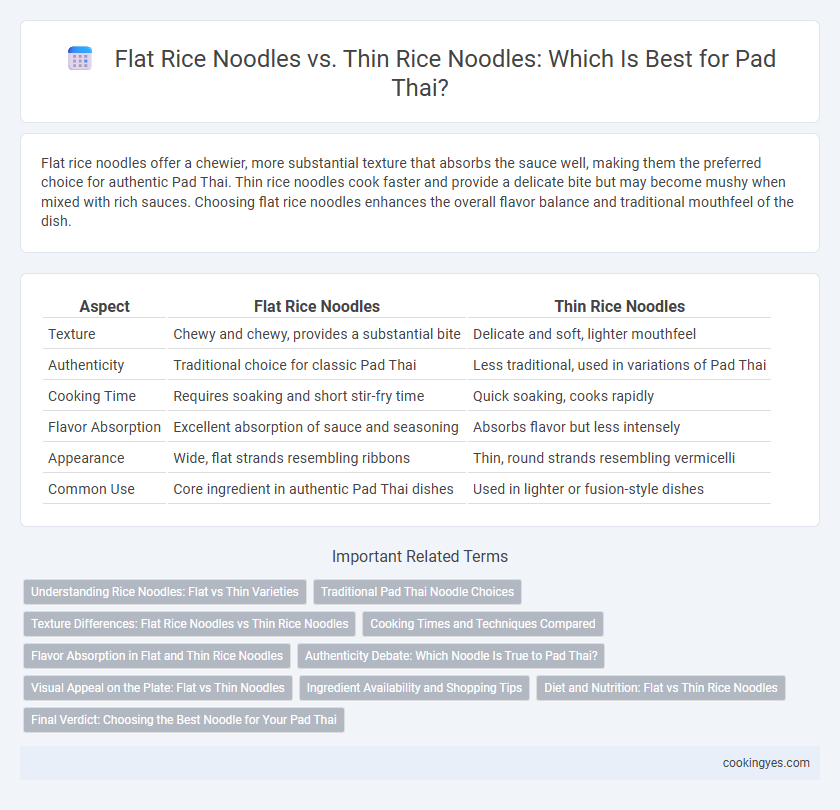Flat rice noodles offer a chewier, more substantial texture that absorbs the sauce well, making them the preferred choice for authentic Pad Thai. Thin rice noodles cook faster and provide a delicate bite but may become mushy when mixed with rich sauces. Choosing flat rice noodles enhances the overall flavor balance and traditional mouthfeel of the dish.
Table of Comparison
| Aspect | Flat Rice Noodles | Thin Rice Noodles |
|---|---|---|
| Texture | Chewy and chewy, provides a substantial bite | Delicate and soft, lighter mouthfeel |
| Authenticity | Traditional choice for classic Pad Thai | Less traditional, used in variations of Pad Thai |
| Cooking Time | Requires soaking and short stir-fry time | Quick soaking, cooks rapidly |
| Flavor Absorption | Excellent absorption of sauce and seasoning | Absorbs flavor but less intensely |
| Appearance | Wide, flat strands resembling ribbons | Thin, round strands resembling vermicelli |
| Common Use | Core ingredient in authentic Pad Thai dishes | Used in lighter or fusion-style dishes |
Understanding Rice Noodles: Flat vs Thin Varieties
Flat rice noodles create a chewier texture and hold sauces better, making them the preferred base for authentic Pad Thai. Thin rice noodles, often used in dishes like Pho, provide a lighter, more delicate bite but may not absorb flavors as effectively in stir-fries. Choosing between flat and thin noodles depends on desired texture and sauce retention for the perfect Pad Thai experience.
Traditional Pad Thai Noodle Choices
Traditional Pad Thai primarily uses flat rice noodles, known as "sen lek," which provide an ideal texture that absorbs the sauce while maintaining a slight chewiness. Thin rice noodles, or "sen mee," are less common and typically used in other Thai dishes, offering a more delicate consistency that can become mushy when stir-fried. The flat rice noodle's wide surface area enhances flavor absorption, making it the preferred base for authentic Pad Thai recipes.
Texture Differences: Flat Rice Noodles vs Thin Rice Noodles
Flat rice noodles offer a chewy, slightly dense texture that holds sauce well, making them ideal for authentic Pad Thai dishes. Thin rice noodles are more delicate and silky, providing a lighter mouthfeel but may clump or break more easily during cooking. The choice between flat and thin rice noodles directly impacts the dish's overall texture, with flat noodles delivering a heartier bite and thin noodles offering a softer, more tender experience.
Cooking Times and Techniques Compared
Flat rice noodles, typically 1/4 inch wide, absorb sauces better and require a soaking time of 20-30 minutes before stir-frying for 3-5 minutes to achieve the ideal soft yet chewy texture. Thin rice noodles, often called vermicelli, need shorter soaking times, around 10-15 minutes, but require careful handling during stir-frying--usually 2-3 minutes--to avoid clumping or breaking. Cooking techniques for flat noodles emphasize tossing gently to coat evenly, while thin noodles demand constant stirring to prevent sticking and maintain their delicate structure.
Flavor Absorption in Flat and Thin Rice Noodles
Flat rice noodles exhibit superior flavor absorption in Pad Thai due to their broader surface area, allowing the sauce and spices to cling more effectively. Thin rice noodles, while delicate and quick to cook, offer less surface contact, resulting in a lighter flavor infusion. The texture contrast between flat and thin rice noodles also influences overall taste perception, with flat noodles providing a chewier bite that enhances the dish's savory complexity.
Authenticity Debate: Which Noodle Is True to Pad Thai?
Flat rice noodles, specifically 1/4-inch wide, are the traditional choice for authentic Pad Thai, providing the ideal texture to absorb the tangy tamarind sauce and stir-fry ingredients evenly. Thin rice noodles, often used in variations or other Thai dishes, tend to become mushy and lack the chewy consistency characteristic of classic Pad Thai. Culinary experts and street vendors in Thailand consistently emphasize flat rice noodles as the true base for preserving historical authenticity and flavor integrity.
Visual Appeal on the Plate: Flat vs Thin Noodles
Flat rice noodles create a broader surface area that better absorbs sauce, enhancing the glossy, vibrant look of Pad Thai. Thin rice noodles result in a more delicate texture but may appear less visually impactful on the plate due to their narrow shape. The choice between flat and thin noodles significantly influences the dish's overall presentation, with flat noodles offering a more traditional and appetizing appearance.
Ingredient Availability and Shopping Tips
Flat rice noodles, often referred to as "sen lek," are the traditional base for authentic Pad Thai and are widely available in Asian grocery stores and online markets. Thin rice noodles, or "sen mee," may serve as a substitute when flat noodles are scarce, though their texture differs slightly, resulting in a less chewy dish. When shopping, prioritize fresh or well-packaged noodles, and consider soaking them properly to achieve the optimal consistency essential for Pad Thai.
Diet and Nutrition: Flat vs Thin Rice Noodles
Flat rice noodles used in Pad Thai typically have a lower glycemic index compared to thin rice noodles, making them a better option for maintaining stable blood sugar levels. They also provide slightly more fiber and protein per serving, which aids in digestion and promotes satiety. Thin rice noodles, while lighter and quicker to cook, tend to have higher carbohydrate content and less nutritional density, impacting diet preferences for those monitoring calorie intake.
Final Verdict: Choosing the Best Noodle for Your Pad Thai
Flat rice noodles, typically 1/4 inch wide, absorb sauces better and provide a chewy texture that is ideal for traditional Pad Thai, while thin rice noodles, also known as vermicelli, tend to become mushy and lose their structure when stir-fried. For an authentic Pad Thai experience with the perfect balance of chewiness and sauce adherence, flat rice noodles remain the best choice. Selecting flat rice noodles ensures your Pad Thai delivers the classic texture and flavor that defines the dish.
Flat rice noodles vs thin rice noodles for Pad Thai base Infographic

 cookingyes.com
cookingyes.com